The right way to ask users to review your app
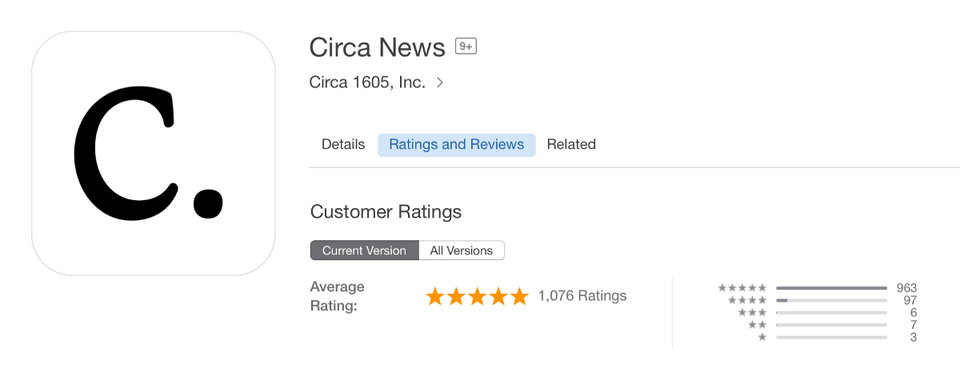
How Circa News got 90% 5-star ratings
Since Circa News has been available in the App Store, we’ve done quite well with our app ratings — nearly every major version has ended up with a 5 star average. That’s no accident. Two things have contributed to that: we’ve always focused an incredible amount on a high quality user experience and we’ve also made sure that the right paths to a review from a user who’s had a positive experience exist. In this piece you’ll read about our learnings over the last few years, and how you might apply them in your app.
App ratings can postively or negatively affect important aspects of how people discover apps.
- In the App Store, app ratings are taken into account for search results, and top chart rankings. Apps that have a lot of ratings, and are rated positively are less prone to fluctuate in the app ranking charts and therefore more likely to hold their positions longer.
- In search results, positive app ratings help an app appear higher in the results.
- On a more personal note, when I see an app with a 3.5 star rating or below I’m hesitant to even install it, fearing a poor experience. I’d assume I’m not alone there.
Because of the above, asking for ratings became a commonplace. The ratings were simply too critical to app discovery and downloads to leave up to chance. But along the way, “begging” for ratings became despised and started to negatively impact apps.
At Circa we’ve worked hard to ensure that everything we do puts our users’ interests first. Asking for feedback and ratings should especially be a net positive user experience.
No one likes your pop up
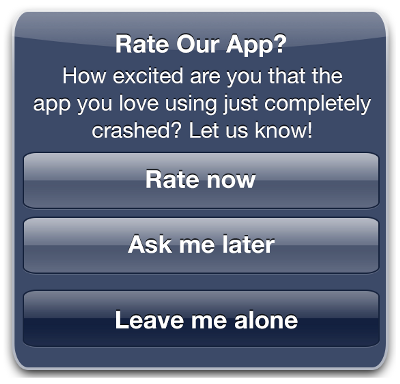
The vast majority of the app rating asks that I’ve ever seen look a lot like the image on the left — a pop up that interrupts your experience. Even Circa had employed this method up until our most recent version, to some early success and then later, issues. But while we did have this pop up in place, it wasn’t shown to just everyone who opened the app.
There are three simple rules:
- Don’t interrupt someone’s experience.
- Don’t ask for an app rating after your app has crashed. That’s just stupid.
- Do delay asking for a rating until there’s a likely moment of constructive feedback (as you’ll read later), or a positive rating.
Apps like HotelTonight ask for a rating after you’ve had a successful experience in booking a room. Someone who’s never completed a room booking is unlikely to give a high rating, so why ask them? But someone who just had a kick-ass experience for a low-cost is going to be stoked to give 5 stars.
With Circa News, since we didn’t have a transactional experience that might result in the previous example, something else was needed. What we decided upon is that we would wait to present the ask until the user has opened the app at least 10 times, over the course of 3 distinct days. This means that we’re self-selecting into a smaller group — sure — but a group that’s more likely to give a positive rating.
While employing the above rules, and still using a pop up, we were able to get incredible ratings. As I mentioned above, every major version of Circa has carried a 5 star average which is extremely rare. But we started noticing something along the way: people were rating us poorly just because we asked for ratings.
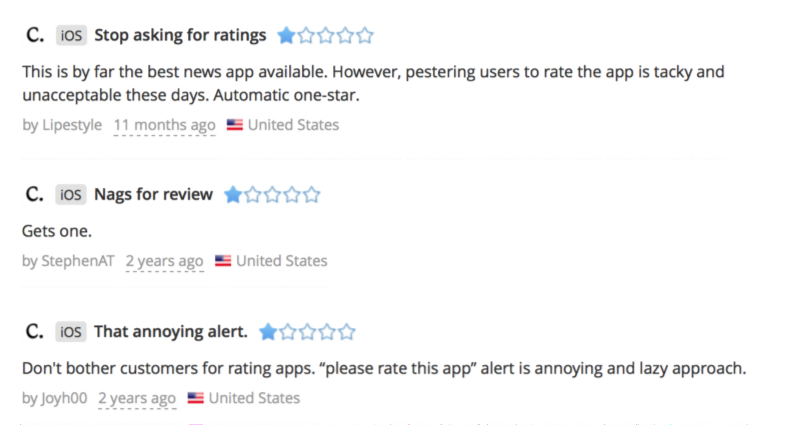
Nearly all of the negative app reviews we got were because we asked for a rating.
So here we have a dilemma: we need ratings to help our app discovery, but by simply asking we might get rated poorly. It then dawned on us that it wasn’t the ask that was the problem, it was the method by which it was done.
Integrated rating requests
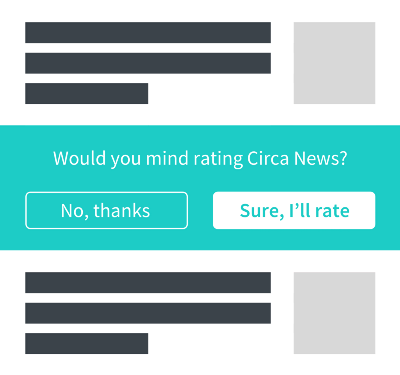
The trouble with the pop up approach is that the app was inevitably interrupting the user’s experience. A method that’s more integral into the experience is the next step — we call this the integrated rating.
For Circa we decided to place an integrated rating in the middle of our list of news stories. That way, someone could scroll right past it without having to interact with it, as opposed to a pop up which requires interaction.
If you have to ask “will this annoy users?” the answer is always yes.
You’ll need to choose a placement that’s appropriate for your app. Perhaps in a shopping app, it would be after someone has successfully placed an order. Or maybe a social app where it’s placed directly within a feed somehow. In any case, the integrated rating should dramatically reduce the annoyance factor, while increasing interaction.
Ask a question. Don’t beg.
In brainstorming our integrated solution we decided to not just ask for the rating straight-up. Instead, we decided to ask a simple question:

Asking for a rating is binary. Users will either rate your app, or they won’t. But the rating itself is not binary — they may still rate your app poorly, such as if they’re annoyed by being asked.
By adding a question into the equation you can actually get valuable feedback from users that aren’t enjoying the app. Tapping “not really” presents our readers with a different question, specifically requesting their feedback. “Yes” will separately lead them to an ask for a rating.
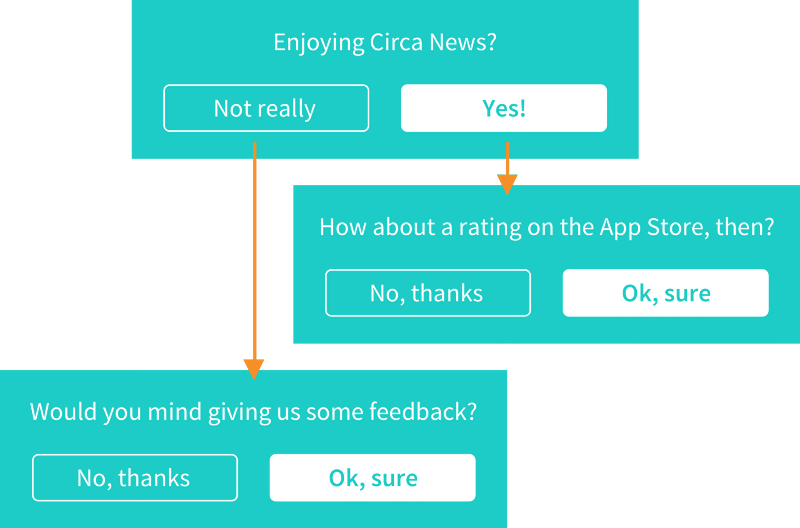
The best part about the above experience is that for those users who are truly not enjoying their experience, they’re giving us their unfiltered feedback. Remember that we still only show this ask after the app has been opened 10 times, over 3 days, and therefore they’re likely to be a somewhat loyal user. If they’re loyal, and not enjoying the app that’s critical to know. The feedback that we’ve received since this has been implemented has been incredible — we’re getting right down to what some folks aren’t enjoying about their time with the app and that feedback will be crucial for any future development.
In Circa News, the feedback itself is collected with a native form that pops up after “Ok, sure” has been pressed. Anything submitted heads directly to our help desk software for processing and response.
While it may be a little less-than-ideal, you could easily replace that native form with popping up an email compose window.
Note: We custom-built everything you’ve read about above. There are a few solutions that deal with components of our methods, but not all. One in particular is Apptentive but at the time of this writing it doesn’t appear that they do anything like our integrated ratings. Perhaps that will change.
Even our readers are noticing! We’ve been seeing a lot of positive tweets about this approach. You read that right — users that are happy to see an ask for ratings.
Android too
We’ve noticed that this approach, coupled with a better app, has worked very well for us on the Google Play Store as well. Here’s what our last six months of ratings looked like there:

One size does not fit all
It should be emphasized that while the principles of what’s mentioned above should hold for anyone that would care to implement anything similar, your specific approach should be unique to your experience and what your users would expect.
It goes without saying that the methods above alone will not get your app to 5 stars. First and foremost the quality of the app actually matters. If your app is poor, you’re still going to get poor ratings. We’ve seen it.
As it stands today, out of 8,699 ratings over the life of the app, Circa News has had 315 one star ratings on the App Store. The vast majority of those were within the first few hours of launch two years ago, when our service was unreachable due to our servers struggling to keep up with the massive traffic. We’ve now spent two years building up our ratings in the hopes that those first few ugly hours don’t haunt us permanently. Over the life of the app now, we have 93% four and five star ratings.
The only way to becoming a 5-star app is to first have an excellent user experience. Once that first requirement is met, implementing a user-friendly feedback system such as the one above should help. Always put yourself in the shoes of your users.